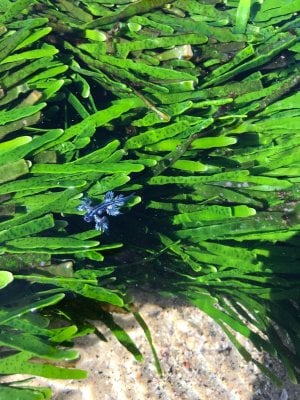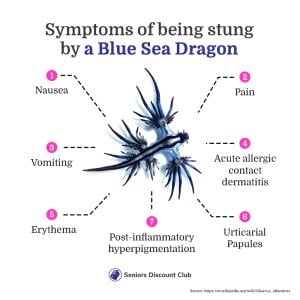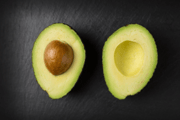Beware! This beautiful but DANGEROUS creature has been spotted on Aussie beaches
- Replies 4
For some, there's nothing more magical than a day at the beach — a day spent in the sun with the sand between your toes and the ocean lapping at your feet.
However, we need to warn you about an eye-catching but dangerous creature making its appearance along our shores.
The bright blue Glaucus atlanticus, commonly known as the blue dragon, has been seen washing up on beaches this month and beachgoers have been cautioned to be wary of the sea slug.
Although the blue dragon may look beautiful with its visually pleasing blue and white colour, the sea slugs can deliver a nasty sting when touched.
That's because the blue dragon eats creatures like the venomous bluebottle (also known as the Portuguese man o’ war), but instead of completely digesting them, it instead stores their stinging cells in sacs on its body.
If disturbed or threatened, it will use these cells as a form of protection — and it's often unsuspecting beachgoers that get caught in the crossfire.
Unfortunately, blue dragons are also quite small — it is noted that they’re usually less than 3cm long, which makes it quite difficult to keep an eye out for them while swimming.
The pain of a blue dragon sting is comparable to being stung by a bluebottle, which makes sense considering what they do with their food.
One student and marine biology enthusiast named Julian Obayd, recently experienced the wrath of the sea creatures first-hand while trying to release them back into the ocean.
‘It hurts like hell,’ he said in a TikTok post, pointing at welts on his stomach caused by blue dragon stings.
If ever you do get stung by a blue dragon, it is advised to wash the affected area with seawater to get the remaining stinging cells off. Take note not to rub the area though as it may agitate the remaining stinging cells!
After, apply hot water (around 40 degrees would be good, or as warm as tolerable) or ice to help with the pain.
As noted earlier, blue dragons use stinging cells from creatures like bluebottles so perhaps the warning from WebMD also applies: ‘Do not treat your bluebottle sting with vinegar or alcohol as they might make the pain worse.’
In case you’re thinking of urine — something most of us grew up hearing as great for stings from sea creatures —- healthdirect makes no note of using it as a cure for any sting.

The Australian Museum is also more straight-to-the-point on using pee for stings: No.
‘Our urine can either be acidic or alkaline and when the latter, could make the sting worse by stimulating more stinging cells to be released,’ they said.
It would also be wise to observe for symptoms of anaphylactic shock such as difficulty breathing and swelling of the tongue and throat area, which could be an extreme reaction to getting stuck.
On such occasions, it is best to call 000 for urgent medical attention.

Since blue dragons and other related marine species are sensitive to water temperatures, climate change has also resulted in an increase in the abundance of the creature along Australia's southeast coastline.
It's believed warming oceans and increased storm activity may have contributed to the blue dragon's distribution along the mainland from southern Queensland to northern Victoria.
So far, no blue dragons have been spotted as far south as Tasmania.

On the topic of Aussie sea critters, you may also want to read this warning of another creature lurking in our waters with a venom ‘more potent than cyanide’.
Or you might want to go through five reasons eels are some of nature’s ‘cool little freaks’.
For now members, we urge you to be wary the next time you head down to the beach and remember that it’s best not to touch or move anything you find in the water.
So, have you ever seen these blue dragons while out on the beach? What are your experiences with them and other creatures that can pack quite a sting?
Tell us your thoughts below!
Source: YouTube/Chad Tam
However, we need to warn you about an eye-catching but dangerous creature making its appearance along our shores.
The bright blue Glaucus atlanticus, commonly known as the blue dragon, has been seen washing up on beaches this month and beachgoers have been cautioned to be wary of the sea slug.
Although the blue dragon may look beautiful with its visually pleasing blue and white colour, the sea slugs can deliver a nasty sting when touched.
That's because the blue dragon eats creatures like the venomous bluebottle (also known as the Portuguese man o’ war), but instead of completely digesting them, it instead stores their stinging cells in sacs on its body.
If disturbed or threatened, it will use these cells as a form of protection — and it's often unsuspecting beachgoers that get caught in the crossfire.
Unfortunately, blue dragons are also quite small — it is noted that they’re usually less than 3cm long, which makes it quite difficult to keep an eye out for them while swimming.
The pain of a blue dragon sting is comparable to being stung by a bluebottle, which makes sense considering what they do with their food.
One student and marine biology enthusiast named Julian Obayd, recently experienced the wrath of the sea creatures first-hand while trying to release them back into the ocean.
‘It hurts like hell,’ he said in a TikTok post, pointing at welts on his stomach caused by blue dragon stings.
If ever you do get stung by a blue dragon, it is advised to wash the affected area with seawater to get the remaining stinging cells off. Take note not to rub the area though as it may agitate the remaining stinging cells!
After, apply hot water (around 40 degrees would be good, or as warm as tolerable) or ice to help with the pain.
As noted earlier, blue dragons use stinging cells from creatures like bluebottles so perhaps the warning from WebMD also applies: ‘Do not treat your bluebottle sting with vinegar or alcohol as they might make the pain worse.’
In case you’re thinking of urine — something most of us grew up hearing as great for stings from sea creatures —- healthdirect makes no note of using it as a cure for any sting.

Blue dragons are a danger to those out enjoying Australia’s summer months. Image Credit: Pexels/Kampus Production
The Australian Museum is also more straight-to-the-point on using pee for stings: No.
‘Our urine can either be acidic or alkaline and when the latter, could make the sting worse by stimulating more stinging cells to be released,’ they said.
It would also be wise to observe for symptoms of anaphylactic shock such as difficulty breathing and swelling of the tongue and throat area, which could be an extreme reaction to getting stuck.
On such occasions, it is best to call 000 for urgent medical attention.
Key Takeaways
- Beachgoers are being warned to be aware of blue dragons, or Glaucus atlanticus, washing up on Australian shores.
- Blue dragons can deliver a painful sting since they store and use the stinging cells of their prey.
- Unfortunately they can be quite difficult to spot due to their size and colouring.
- Symptoms of a blue dragon sting are pain in the affected area and may also progress to a severe allergic reaction, so if stung it is best to get medical attention.
It's believed warming oceans and increased storm activity may have contributed to the blue dragon's distribution along the mainland from southern Queensland to northern Victoria.
So far, no blue dragons have been spotted as far south as Tasmania.

Blue dragons float just below the surface of the water as seen in this photograph. Image Credit: Reddit/user danroa123
On the topic of Aussie sea critters, you may also want to read this warning of another creature lurking in our waters with a venom ‘more potent than cyanide’.
Or you might want to go through five reasons eels are some of nature’s ‘cool little freaks’.
For now members, we urge you to be wary the next time you head down to the beach and remember that it’s best not to touch or move anything you find in the water.
So, have you ever seen these blue dragons while out on the beach? What are your experiences with them and other creatures that can pack quite a sting?
Tell us your thoughts below!
Source: YouTube/Chad Tam








